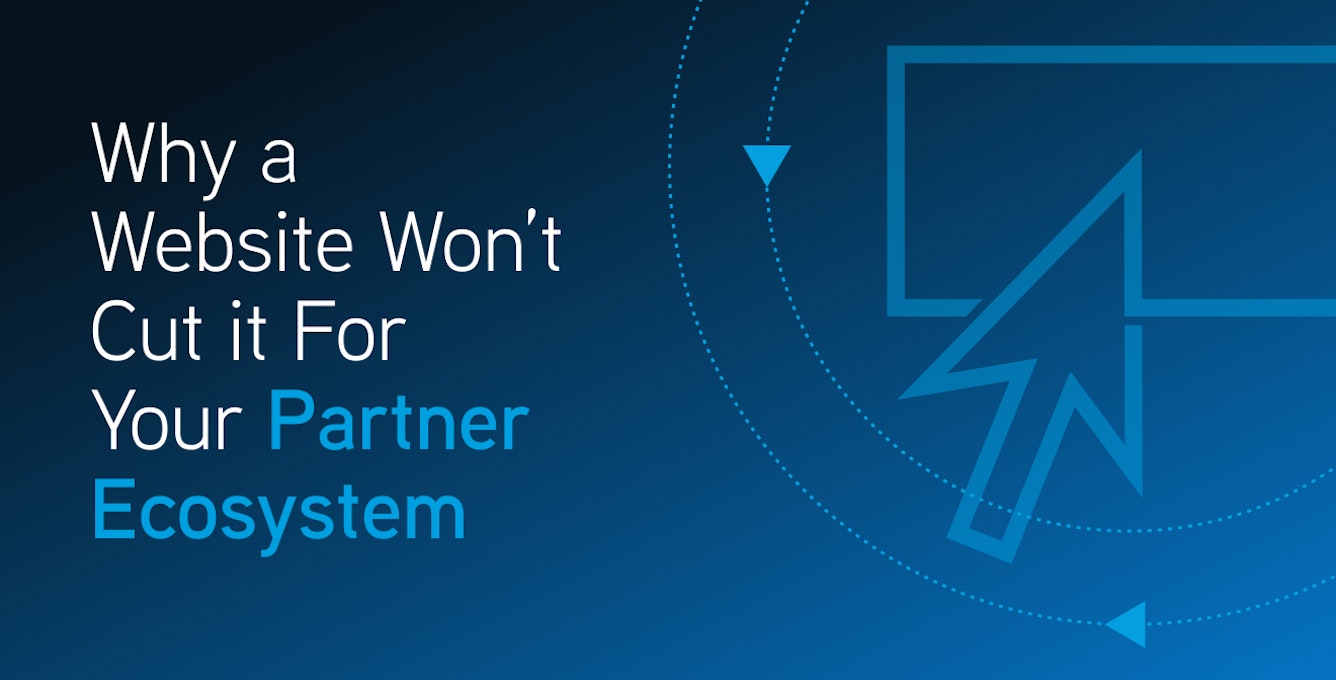Strategy & Best Practices
Why a Website Won’t Cut it For Your Partner Ecosystem
By Vera Barile / March 17, 2022

The SaaS model isn't going anywhere. Its rapid expansion continues at a jaw-dropping pace. SaaS spending across companies is expected to reach a value of $500 billion by the year 2023. Organizations value SaaS because it reduces time spent on data configuration and deployment, plus it gives customers easy access to software updates, add-ons, and integrations. However, creating new solutions and solving all customer pain points all the time—and at a pace customers demand—is almost impossible for software companies. Few have the technical talent or resources to keep pace.
Instead, software companies should consider expanding their partner ecosystems. A solid partner ecosystem is all about linking your customers with third-party vendors whose solutions integrate with or complement yours. This requires showcasing partner solutions to customers online, often referred to as a partner add-on store, app store, or marketplace. There are a few ways to build and launch a partner marketplace. Though your website could do the trick, many opt for a marketplace platform explicitly created for managing and showcasing partner solutions. Let’s dive into the ins and outs of these options.
A website vs. marketplace platform— which wins?
Websites are essential for showcasing your brand while informing visitors about your service and product offerings. Websites can range from simple to a fully transactional experience, complete with a purchase flow.
As you strategize about connecting customers with partner solutions, keep in mind your business objectives. As we talked about in a recent post, partnerships are a long game. Building relationships and driving new revenue streams take effort, and your partners want to see that you're committed to putting their offering in a good light, as well as delivering an optimal experience for your shared customers. Your in-house IT team can probably stage a webpage with partner logos, which will redirect your customers to various partner websites. In this scenario, your team would rely on its Content Management System (CMS) to create, manage, and modify content on your partner website.
However, by launching a partner website and using your current CMS, the customer experience may become fragmented. To research partner solutions, customers have to visit multiple partner websites and sift through product profiles to compare products, features, and available offerings, which is time consuming and may leave them frustrated.
Delivering maximum value to customers requires giving them a unified view of partners and product profiles, where partner listings are consistent and comprehensive. While expanding your legacy website to include this type of functionality is possible, it might not be cost-effective or set you up for success as your business scales.
The hidden costs of CMS-powered partner website
Because most CMSs lack out-of-the-box functionality for advanced use cases, customizations are often time-consuming and expensive. You'll need to factor in costs for designing and developing several net-new partner website components: provider/vendor profiles, product profiles, related products, customer review functionality, the ability to share multimedia assets and downloadable content, and more. Additional cost considerations include design and development, customizations for new modules, maintenance, hosting, and transitioning to a commerce-enabled site when ready.
Cost breakdown of a CMS-powered partner marketplace

1. Web hosting cost estimates
2. Security and maintenance cost estimates
3. Design and development (UI/UX) cost estimates
Marketplace platform pros
As you can see, there are a lot of factors to consider when evaluating partner marketplace options. It’s also important to keep in mind that customizations and add-ons get expensive fast as your partner community expands. A marketplace platform can help speed time to market in launching your partner ecosystem, and it ensures you can deliver a cohesive user experience that delivers maximum value to the customer and partner. Let’s cover the biggest advantages of a B2B marketplace platform, so you can decide what’s best for your business.
1. Secure and streamlined partner access - Granting guests access to your website can cause IT compliance issues. Even if it’s permitted, limiting access to their own profile and lead information can be challenging. A key benefit of using a marketplace development platform with expressly designed user permissions for this use case is that it’s easy and secure to invite partners to collaborate. You can limit user access and visibility, empowering them to help keep their product information up to date but restricting their ability to disrupt your marketplace operations.
2. Partner self-service options - The more partners you onboard, the more products and product profiles you will need to maintain. You will want to ensure content, such as pricing and descriptions, stays current. Given your partners are the experts of their products, a marketplace platform allows you to set up user permissions, so it’s easy to invite partners to collaborate securely and manage their own rich product profiles, add multimedia assets, downloadable content, and more.
This avoids lengthy turnaround times for product updates and keeps partner information up-to-date. It also allows your team to focus their efforts where it matters most. These types of self-service capabilities are essential as your program scales.
3. Simplified merchandising and content management - Marketplace platforms allow you to easily merchandise and manage content all in one place with dedicated, out-of-the-box components. This enhances the discovery experience for customers. Organizations can leverage tags and ribbons to better categorize and present partner solutions. Using the self-service options, partners can provide visually-rich product profiles featuring hi-res photos and videos, ratings and reviews, and downloadable marketing materials. A marketplace platform also supports SEO and SEM strategies, including options to toggle between promotional marketplace themes and always-on themes to drive engagement.\
4. Consumer-like search, filtering, and product types- More than half—52 percent—of B2B buyers reported they were frustrated with online buying experiences in 2021. Software companies need to prioritize digital transformation and deliver consumer-like experiences to build brand loyalty and stay competitive. Getting there means creating an optimal browsing experience and giving users advanced search and filtering capabilities. This way, customers can quickly locate solutions. Instead of relying on CMS plug-ins and requiring custom development, a marketplace platform gives you and partners the built-in ability to efficiently tag and craft profiles, so results are searchable and easily filtered.
The ability to set up product types out-of-the-box with a partner listing— SaaS, integrations/connectors, extensions, data, API access, downloadables, services, physical goods, and more— is also valuable because it gives organizations the ability to scale and expand their partner ecosystems to include additional services overtime.
5. Move beyond Google Analytics - While Google Analytics provides a solid baseline for tracking website visitor sessions and pageviews, it doesn’t give a comprehensive picture of partners or customer interest. Beyond Google Analytics tracking, a marketplace platform lets you collect lead information directly. It includes built-in functionality to automate the referral management process. Users simply fill out a form to submit their information, allowing you to manage the referral directly from your dashboard. Partners can also gain visibility by logging into the same instance to keep track of referrals.
This provides greater visibility into specific customer interests and it opens up opportunities to deepen the relationship. Partners can access these leads directly and receive notifications when customers inquire, adding data security and standards compliance without impeding visibility. By automatically capturing leads and assigning them to partners, these marketplace components ensure companies provide timely customer follow-up. These features allow for a better user experience for the end customer while fortifying the relationship you have with your partner.
6. Commerce-enable when ready - Marketplace platforms drive efficiencies because they allow you to turn on commerce capabilities when you’re ready. You can take the listing showcase you’ve worked so hard to build and you can transition it to a transactional marketplace at the right time. To start transacting with a CMS-powered partner listing, it would require the migration of partners’ product profiles to a new platform or adding on commerce capabilities, likely from multiple vendors. If you work with a marketplace platform from the get-go, there’s no manual porting over of content. You simply add the transactional layer to your storefront by enabling a checkout process. Plus, unlike a traditional ecommerce website, a partner marketplace includes functionality to efficiently sell digital subscription services alongside physical goods. It also lets you outline purchase options, such as setting up categories for selling one-time services vs. selling recurring subscriptions.
Don’t fall into the partner website trap
As you build out your partner strategy, talk to stakeholders about potential costs and the pros and cons of using your legacy website for your partner ecosystem. AppDirect offers a free 30-trial of AppDirect Starter—a cloud-based B2B digital marketplace—that lets you launch your partner marketplace quickly. You’ll be able to customize your storefront with your branding, build out product profiles, and invite team members and partners to collaborate.
Related Articles

Strategy & Best Practices
How to Create a Better Marketplace Experience with Composable Commerce
Composable commerce is redefining how marketplaces engage customers and partners by delivering unmatched personalization and agility. Learn how to use headless APIs, extensions, and automation to create standout, flexible commerce experiences that keep you ahead of the competition.By Jonmichael Moy / AppDirect / November 26, 2025

Strategy & Best Practices
Get Comfortable Talking Security with Your Customers
A practical guide for tech advisors to confidently engage in cybersecurity conversations, understand risks, and support customers with essential security knowledge and resourcesBy Denise Sarazin / AppDirect / August 22, 2025

Strategy & Best Practices
Grow Your Revenues Through New Routes to Market
Explore four proven strategies to broaden your routes to market, sell more effectively into the SMB market, and achieve maximum revenue growthBy Denise Sarazin / AppDirect / August 21, 2025